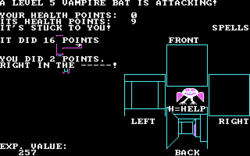- Moraff's Revenge
-
Moraff's Revenge 
In-game screenshotDeveloper(s) Moraffware[1] Publisher(s) Morraffware[1] Programmer(s) Steve Moraff[1] Platform(s) MS-DOS Release date(s) - NA 1988
Genre(s) Role-playing game[1] Mode(s) Single player Media/distribution Floppy Moraff's Revenge is a role-playing game which provides a 3D first-person perspective for its players.
The objective of the game is to create a character to explore a series of dungeons in order to destroy monsters, gain experience, find treasures, and reach the Fountain of Youth (which is on level 70). It was created by Steve Moraff in 1988.
Contents
Summary
Gameplay
Players begin by creating their own character or using The First Character, which is provided by the game. Racially, characters can be humans, elves, dwarves, or hobbits. Since MR is a simple RPG there are only two class options, fighter or wizard. The statistics are generated randomly and can be re-generated any number of times. The final step is to enter a name for the new character. The player's character is represented by an arrow on the dungeon map. There are two movement modes. In one mode, the left and right arrow keys will turn the character and the up arrow will move the character forward. In the other, the arrow keys will move in each direction the indicate.
Players can explore the dungeon, a maze in which each level is different. There are 70 dungeon levels, each progressively more difficult. The monsters appear in a 3-D view on the right. Each type of creature has a different graphical image but a level 1 orc has the same picture as a level 50 orc. Experience points, money and items are all earned by killing monsters. Monsters, which vary from insects, frogs and centipedes on to more traditional RPG foes like orcs, can be killed by striking them with weapons or casting spells to lower their hit points below zero. However, monsters will fight back and can kill the player.
Ladders lead up and down, and trap doors can drop players multiple levels. Movement may also be done by teleportation. Down ladders are represented by a solid green square and up ladders are represented by an empty green square. Only a small section of the town is mapped at first. The player must map the rest of the town and the entire dungeon by exploring them.
Earning experience points is a critical part of the game. Experience points, once "absorbed" by staying at the Inns, can lead to the player gaining levels. Without the higher hit points, spell points, and greater skill with weapons that higher levels provide the player, deeper dungeon levels become exceedingly difficult. Some players, however, enjoy testing their skills by seeing how deep in the dungeon they can survive at low levels of experience.
Town
The Town is the ground level. The town contains a bank, inns, temples, stores, and a wizard's guild. The bank is where the player exchanges treasure for money and deposits and withdraws money. The inns are places to sleep and staying at an inn will raise a character's level, if they have enough experience points. There are three inns. The Flea Bag Inn costs 10 jewel pieces to stay a night. However, staying here can result in getting robbed or catching a disease. The Yuppydom Inn costs 200 jewel pieces. The Kings Inn cost 6000 jewel pieces and a staff cleric will heal all the character's wounds. The Stores sell weapons and armor, or you can buy The Town for 1000000 jewel pieces. The Temple sells healing, disease and poison cures, and a level gain. The Wizard's Guild will tell the player what different spells do.
Winning
Finding the Fountain of Youth will restore the player to level 0 and re-create all 70 dungeon levels with new configurations. However, the player retains all stats and items after drinking from the Fountain. The Fountain of Youth is in a different location each time, but presumably always on level 70. MR is typical of early computer and console games in as much that the end is not, in many senses, a true ending, but simply re-iterates the game for the player.
See also
References

This roguelike article is a stub. You can help Wikipedia by expanding it.
